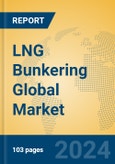Market Size and Growth Forecast
The global LNG bunkering market is projected to reach between USD 1.0 billion and USD 1.8 billion in 2025, with a compound annual growth rate (CAGR) of 10% to 15% through 2030, reflecting the accelerating adoption of LNG as marine fuel and expanding bunkering infrastructure development.Regional Analysis
North America: The United States leads with extensive LNG export capabilities and developing bunkering infrastructure, while Canada focuses on Arctic shipping routes and coastal bunkering facilities. Europe: The Netherlands and Germany dominate with advanced bunkering infrastructure and regulatory frameworks, while Norway emphasizes Arctic LNG operations and environmental standards. Asia Pacific: China and Japan experience rapid growth driven by LNG import demand and bunkering infrastructure development, while Singapore serves as a major bunkering hub for the region. Rest of the World: The Middle East, particularly Qatar and UAE, leverages LNG production capabilities for bunkering services, while Latin America develops coastal bunkering infrastructure.Application Analysis
- Container Fleet: Expected growth of 11.0-16.0%, driven by major shipping lines' adoption of LNG-fueled vessels and environmental compliance requirements. Trends focus on hub-and-spoke bunkering models and integrated supply chain solutions.
- Tanker Fleet: Projected growth of 10.5-15.5%, linked to the dual-fuel vessel adoption and operational efficiency improvements. Developments emphasize safety protocols and specialized handling equipment.
- Cargo Fleet: Anticipated growth of 10.8-15.8%, tied to bulk carrier and general cargo vessel conversions. Advances prioritize flexible bunkering solutions and route optimization.
- Ferries: Expected growth of 12.0-17.0%, driven by short-sea shipping and passenger vessel environmental requirements. Trends highlight rapid bunkering capabilities and shore-side infrastructure.
- Inland Vessels: Projected growth of 9.5-14.5%, linked to river and canal transportation systems. Developments focus on small-scale bunkering solutions and mobile supply systems.
- Others: Anticipated growth of 10.2-15.2%, including specialized vessels and emerging applications. Developments prioritize niche market solutions and customized bunkering services.
Type Analysis
- Truck-to-Ship: Expected growth of 9.8-14.8%, valued for flexibility and accessibility in ports without dedicated LNG infrastructure. Trends focus on mobile bunkering units and rapid deployment capabilities.
- Port-to-Ship: Projected growth of 11.5-16.5%, crucial for high-volume bunkering operations and major shipping routes. Advances highlight automated systems and large-scale storage facilities.
- Ship-to-Ship: Anticipated growth of 12.0-17.0%, essential for mid-ocean bunkering and strategic locations. Developments prioritize specialized bunker vessels and transfer safety systems.
- Portable Tanks: Expected growth of 10.0-15.0%, important for remote locations and flexible supply solutions. Trends emphasize standardized containers and intermodal transportation capabilities.
Key Market Players
Leading firms include Petronas, offering integrated LNG supply chain solutions; KOREA Gas Corporation, providing LNG infrastructure and bunkering services; TotalEnergies, delivering comprehensive energy solutions and marine fuels; Trelleborg, specializing in marine and offshore systems; Wartsila, focusing on marine power solutions and LNG systems; Harvey Gulf International Marine, providing offshore vessel services and LNG solutions; Chart Industries, offering cryogenic equipment and infrastructure; SHELL, delivering integrated energy solutions and marine fuels; and Gasum, specializing in LNG supply and bunkering services. These companies drive market growth through infrastructure investment, technological innovation, and strategic partnerships across the LNG value chain.Porter's Five Forces Analysis
- Threat of New Entrants: Moderate, due to high capital requirements for infrastructure development and technical expertise needs, though established energy companies can enter with existing capabilities.
- Threat of Substitutes: Low to Moderate, as LNG competes with other alternative marine fuels such as methanol, ammonia, and hydrogen, though LNG currently offers the most mature technology.
- Bargaining Power of Buyers: Moderate, with shipping companies seeking cost-effective, reliable LNG supply while managing fuel cost volatility and operational requirements.
- Bargaining Power of Suppliers: Moderate, with LNG suppliers having leverage through infrastructure control, though increasing competition reduces individual supplier power.
- Competitive Rivalry: High, with firms competing on infrastructure development, supply reliability, pricing, and geographic coverage.
Market Opportunities and Challenges
Opportunities: Stringent environmental regulations drive continuous demand for cleaner marine fuels and LNG bunkering infrastructure development. The expansion of LNG-fueled vessel orders creates sustained demand for bunkering services and infrastructure investment. Technological advancements in cryogenic handling, automated bunkering systems, and safety technologies enhance operational efficiency and market growth. Emerging markets in Southeast Asia, Africa, and Latin America present significant growth potential as these regions develop LNG infrastructure. The trend toward integrated energy solutions and supply chain optimization creates new business models and service opportunities.Challenges: High capital requirements for bunkering infrastructure development create barriers to market entry and expansion. Regulatory complexity and varying international standards complicate global operations and infrastructure development. LNG price volatility and supply chain disruptions affect operational costs and customer demand. Safety and environmental concerns require continuous investment in advanced technologies and training programs. Competition from alternative marine fuels and propulsion technologies creates uncertainty in long-term market demand.
This product will be delivered within 1-3 business days.
Table of Contents
Companies Mentioned
- Petronas
- KOREA Gas Corporation
- TotalEnergies
- Trelleborg
- Wartsila
- Harvey Gulf International Marine
- Chart Industries
- SHELL
- Gasum








